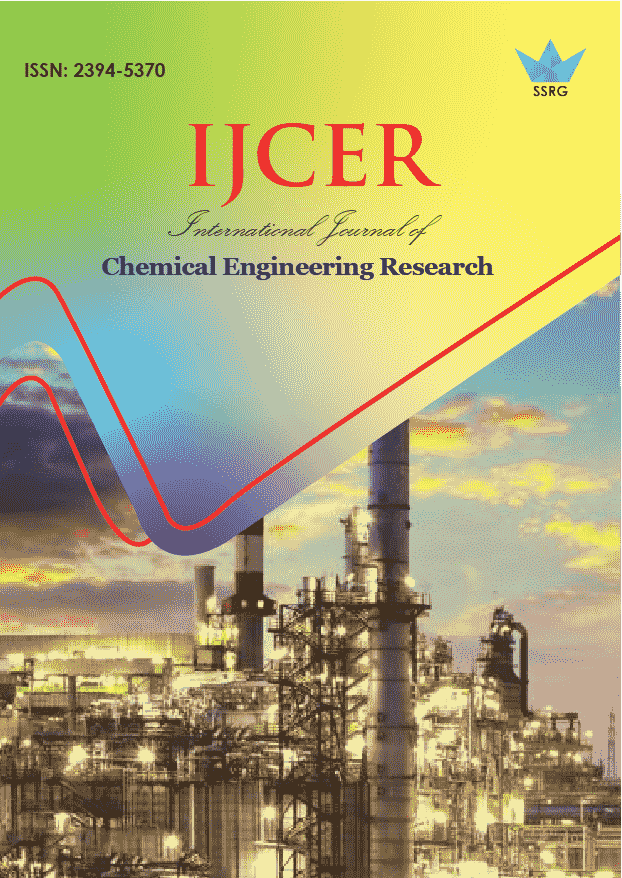Analysis and Classification of Nigerian Crude Oil Types for Modular Refinery Operations

| International Journal of Chemical Engineering Research |
| © 2022 by SSRG - IJCER Journal |
| Volume 9 Issue 2 |
| Year of Publication : 2022 |
| Authors : Adeloye, Olalekan Michael, Cyrus Aseibichin, Afolayan Joel Tobi |
How to Cite?
Adeloye, Olalekan Michael, Cyrus Aseibichin, Afolayan Joel Tobi, "Analysis and Classification of Nigerian Crude Oil Types for Modular Refinery Operations," SSRG International Journal of Chemical Engineering Research, vol. 9, no. 2, pp. 17-24, 2022. Crossref, https://doi.org/10.14445/23945370/IJCER-V9I2P104
Abstract:
This study proposed the revampment of the four major refineries and the operation of conventional modular refineries in the localities for efficient and adequate availability of petroleum products. Hence, the research focused on the suitability and operations ofthe conventionalmodular refinery process by considering twenty (20) different types of Nigerian crude oil for crude oil assay analysis and classification using Aspen Hysys. The crude oil assay analysis results categorized the twenty Nigerian crude oil types as Sweet crude (sulphur content below 0.5wt%), Light crude oil (API value above 38), and Medium crude oil type (API value between 22 and 28). Also, the Nigerian crude oil types were grouped based on their percentage recovery volume at a true boiling point of 3700C as Group A (crude oil with recovery volume above 80% and residual percentage less than 20%), which is suitable for modular refinery operations in Nigeria. In comparison, Group B (crude oil with recovery volume between 70% and 79% and residual percent of over 20%) and Group C (crude oil with recovery volume below 70% and residual percentage value above 30%) are proposed for modified modular refinery process due to its high residual percent (above 20%) or are transported via pipelines or tankers to the major conventional refinery for the further operational process.
Keywords:
Crude Assay, API Value, Watson Factor, Sulphur Content, Recovery Volume, Aspen Hysys.
References:
[1] Colwell R. F, “Oil Refinery Processes: A Brief Overview,” Tennessee: Process Engineering Associate Publisher, 2009.
[2] James G. S, “The Chemistry and Technology of Petroleum,” Boca Raton, Florida: CRC Press, 2014.
[3] Brian B, “Petrolia: The Landscape of America's First Oil Boom,” Baltimore: Johns Hopkins University Press, 2000.
[4] Feng L, Hu Y, Hall C. A. S & Wang J, “The Chinese Oil Industry: History and Future,” NewYork: Springer-Verlag Publisher, 2013.
[5] Gary J. H & Handwerk G. E, “Petroleum Refining Technology and Economics,” New York: Marcel Dekker Incorporated, 2001.
[6] Spataru C, “Whole Energy System Dynamics: Theory,” Modelling and Policy, London: Routledge Publisher, 2017.
[7] Leone J & Leone W, “The Process of Crude Oil Refining, Department of Energy and Mineral Engineering,” Pennstate College of Earth and Mineral Science, 2014, [Online]. Available: https://www.e-education.psu.edu/eme801/node/470
[8] Bello S. K, Lamidi S. B & Bello K. A, “A Review of Sustainable Modular Refineries Development in Nigeria: Prospects and Challenges,” Global Scientific Journal, vol. 8, no. 10, pp. 1230-1240, 2020."
[9] Ogbuigwe A, “Refining in Nigeria: History, Challenges and Prospects,” Applied Petrochemical Research, vol. 8, pp. 181-192, 2018.
[10] Nwaozuzu C, “Crude Oil Refining in Africa and the Way Forward,” Energy Mix Report, 2014, [Online]. Available: http://energymixreport.com/crude-oil-refining-in-africa-the-way-forward/
[11] Nigerian Society of Chemical Engineers, NSChE, “The Modular Refinery Strategy,” The Nigerian Society of Chemical Engineers Newsletter, vol. 2017, no. 1, pp. 12-14, 2017.
[12] Iheukwumere O. E, Moore D & Omotayo T, “Investigating the Challenges of Refinery Construction in Nigeria: A Snapshot across Two-Time Frames over the Past 55 Years,” International Journal of Construction Supply Chain Management, vol. 10, no. 1, pp. 46- 72, 2020.
[13] Mamudu A. O, Igwe G. J & Okonkwo E, “Process Design Evaluation of an Optimum Modular Topping Refinery for Nigeria Crude Oil Using Aspen Hysys Software,” Cogent Engineering, vol. 6, no. 1, pp. 1-8, 2019a.
[14] Mamudu A, Okoro E, Igwilo K, Olabode O, Elehinafe F & Odunlami O, “Challenges and Prospects of Converting NigeriaIllegal Refineries to Modular Refineries,” The Open Chemical Engineering Journal, vol. 13, pp. 1-6, 2019b.
[15] Ogbon N. M, Otanocha O & Rim-Rukeh A, “An Assessment of the Economic Viability and Competitiveness of Modular Refinery in Nigeria,” Nigerian Journal of Technology, vol. 37, no. 4, pp. 1015-1025, 2018

 10.14445/23945370/IJCER-V9I2P104
10.14445/23945370/IJCER-V9I2P104